Plastic kitchen apron: features, types and installation tips
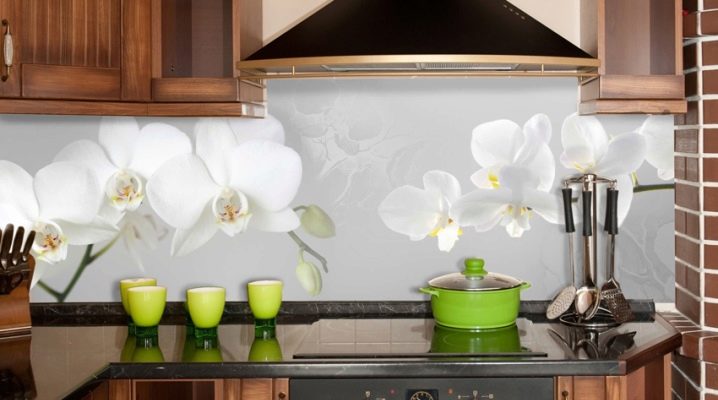
The kitchen is a multifunctional room. Here they prepare food, receive guests and gather household members for lunch or dinner. That is why they try to design the kitchen in an apartment or a private house so that it is cozy and beautiful.
When decorating this room, special attention is usually paid to the wall located along the hob, sink and countertop. This area is called an apron. Various materials can be used for its design, but today we will talk about plastic wall panels.
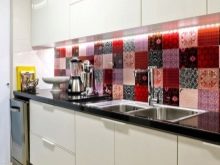
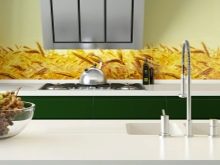
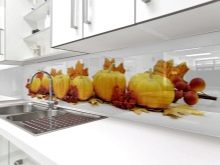
Varieties
Ceramic tiles, glass, various types of stone, wood can be used for finishing the apron. All these materials are aesthetic and durable, but have a significant drawback - high cost. Due to the high cost and complexity of their installation, more and more people prefer plastic panels. With the help of such material, you can do the finishing with your own hands, spending a minimum of time and money.
Those who decide to purchase plastic should decide which type of material to use.
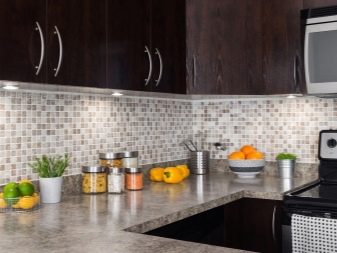

Manufacturers offer several varieties of plastic products, each of which has certain performance characteristics and features.
- ABS plastic... Polymeric material, in the production of which acrylonitrile, butadiene and styrene are used. The material appeared on the construction market recently, but has already won the trust of a large army of consumers. Externally, ABS plastic can be panels with a mirror coating or applied photo printing. A wide range of design solutions will allow you to choose the best option for any interior style.
- Polycarbonate or acrylic glass... A type of plastic that has become an alternative to tempered glass or has been skinned. It is chosen for its affordable price and ease of installation. Externally, polycarbonate is similar to silicate glass - it is perfectly smooth and transparent, has a characteristic shine.
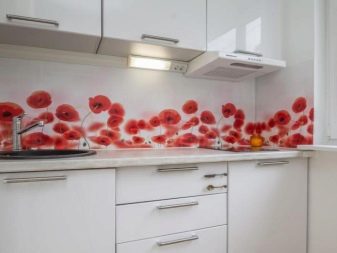
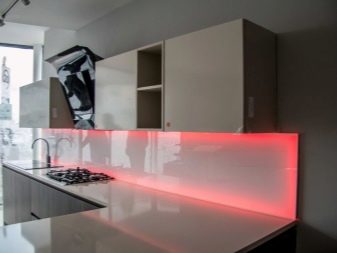
- PVC panels... The most budgetary material from the family of plastic products. It is produced in the form of sheets or lining (rack version). Most often they are used by developers, people on a budget or those who want to update the kitchen in a rented apartment a little. Outwardly, such panels can imitate various natural materials, be monochromatic, with patterns or designs.
To determine which type of decorative plastic to choose for the kitchen, you should study their advantages and disadvantages, as well as the features of operation.
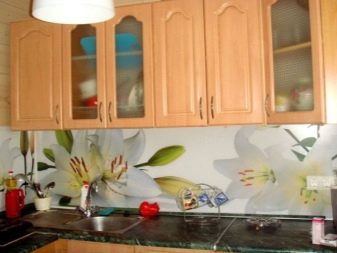
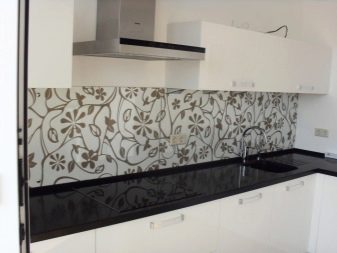
Advantages and disadvantages
All types of plastic wall panels have similar benefits.
These include:
- a huge selection of design solutions - each buyer will choose an option for himself in accordance with his taste preferences;
- resistance to high humidity is an important criterion, since the apron is constantly in contact with splashes from water and grease;
- ease of care;
- convenient processing - plastic products can be easily cut, which is especially important when creating holes for installing sockets;
- low cost;
- lightweight installation - people who bought plastic products do not have to spend money on hiring a master to install them.
The disadvantage of all plastic panels is considered their "fear" of high temperatures.To secure the apron, it is necessary to install protection next to the stove or hob - a glass screen. After reviewing the general characteristics, you need to consider the advantages and disadvantages of each type of plastic panel.
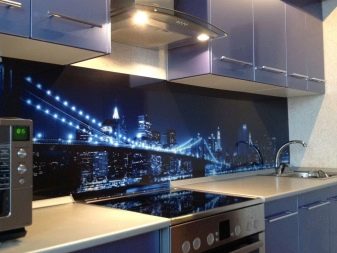

ABS plastic
Such products are not the cheapest option. Their cost is roughly similar to the prices for ceramic tiles. Of all the plastic products for finishing an apron, ABS plates are the most expensive. The disadvantages also include the yellowish tint of the panels, which becomes more pronounced during operation and exposure to sunlight. In addition, when exposed to the sun, the pattern fades, monochromatic products also lose their brightness.
The disadvantages of ABS panels include.
- Poor resistance to abrasion and various mechanical stress. To maintain the cleanliness of such products, use only mild abrasives. Using a coarse brush will scuff and scratch the surface of the finishing material.
- "Fear" of ammonia and various organic solvents.
- Short service life. Subject to the rules of installation and operation, the products will last no more than 5 years, after which they will have to be changed.
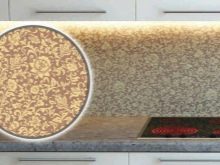
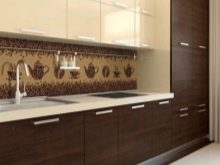

ABS plastic has many advantages. These include the lightness of the material, which facilitates its transportation and installation. Also, one of the main advantages of this cladding is its environmental friendliness. It does not emit harmful substances during operation and heating. The product is able to withstand a wide temperature range without changing its appearance.
ABS plastic has good flexibility. Because of this, it is easy to mount it on an uneven wall surface. But if the wall has obvious bumps or other imperfections, the panels may collapse in waves... In addition, ABS products are impact-resistant, which makes them reliable.
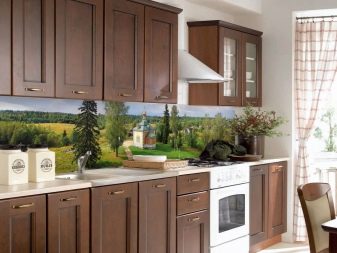

Polycarbonate
An apron made of this material will last a long time without losing its original appearance. Over time, the products do not fade and retain their rich colors even when exposed to the rays of the sun. In appearance, polycarbonate resembles glass - the material is smooth and transparent. However, it is much cheaper than tiles or glass panels. Polycarbonate is resistant to various mechanical influences - it is not afraid of shocks or falls from a height.
It also features increased bending strength. Acrylic glass is fireproof. When exposed to high temperatures, it will melt rather than burn. When melted, the elements will not release toxic substances. Polycarbonate also has minor drawbacks.
One of its main disadvantages is poor abrasion resistance. Because of this, it cannot be rubbed with coarse brushes or sponges using hard abrasive particles.

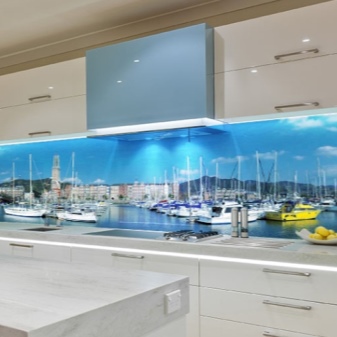
Pvc
The cheapest option. Its financial availability is one of the main advantages. It is much cheaper than polycarbonate or ABS products. Unfortunately, this facing material has more disadvantages than advantages.
Its disadvantages are as follows.
- Fragility... PVC panels are easily scratched when wet cleaning. Considering that the apron gets dirty quickly due to splashes on it when cooking, it will require daily maintenance. After about 2 years of intensive use, the panels will need to be replaced.
- Burnout... Under the influence of the sun's rays, PVC products fade and acquire a yellowish tint.
- "Fear" of products with abrasives and tin sponges.
- Poor resistance to high temperatures... Because of this, the material should not be used to cover the area located next to the hob. It should be noted that when heated, PVC products begin to emit substances harmful to human health.
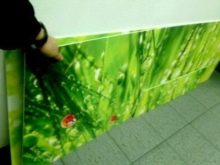
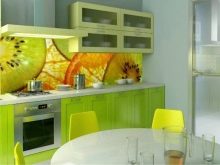
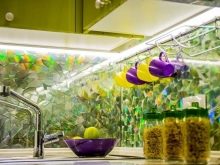
If the buyer purchased an uncertified product, it is likely that it will be of poor quality. These PVC panels are often made from cheap and harmful raw materials.As a result, they are not environmentally friendly.
During operation, low quality PVC cladding will release toxins that gradually poison the human body.
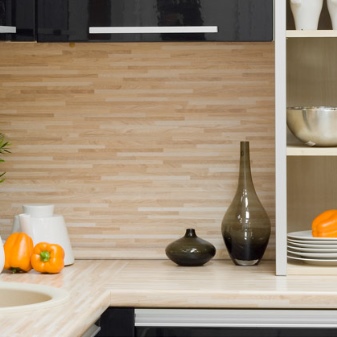

Design options
Plastic is a material on the surface of which any design ideas can be realized. Apron finishing products are sold in any color scheme. The stores offer models from delicate pastel shades to more intense and flashy colors. In this case, the panels can be matte or glossy, have a relief surface, be with a pattern or with a photo print. There is also a black and white plastic for the apron on sale.
Here are the most common design variations for plastic aprons.
- Imitation of natural or artificial materials... Plastic panels for brick, mosaic, board, porcelain stoneware, marble or other facing are very popular.
- With images of fruits, berries or flowers... Such aprons are distinguished by brightness and saturation of shades, catchy. This option is perfect for those who want to emphasize the image.
- With a mirror surface... Such a perfectly smooth apron can add flavor to the interior of any kitchen. However, this is not a practical option. On the mirror surface, stains, drops from splashing water and various contaminants will be striking. To maintain the aesthetics of the apron, it will have to be washed constantly, which negatively affects its durability.
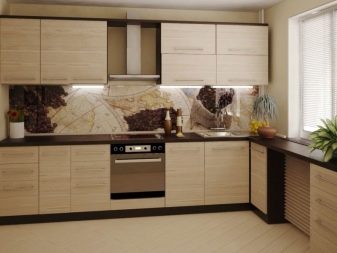
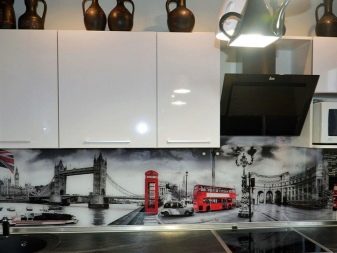
- City images... Ideal for urban kitchens.
- Solid variations... If you wish, you can choose plastic with the desired shade: white, gray, pink, red, purple, black and other tones. In addition, the products are sold with different texture options, which also expands the range of products. Such variations are often chosen by owners of a corner kitchen.
The most common aprons are with photographic images of different subjects. It can be animals, birds, forest glades, various landscapes, still lifes. The choice of design for an apron is an individual decision. It is based on the personal preference of the buyer.
It is worth considering that there are not so many ready-made options with photo printing. In most cases, such panels are made to order, which imposes additional cost on the finished product.

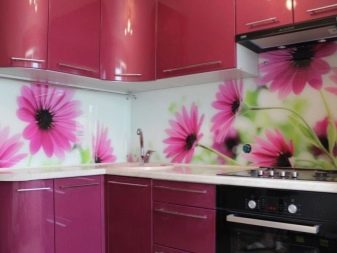
How to choose?
When buying a finishing material for arranging an apron, you should pay attention to several important parameters.
- Dimensions of plastic... Plain wall panels or PVC printed products are sold with a width of 15 to 50 cm or in the form of slabs (dimensions vary widely: from 30 * 30 to 98 * 98 cm). In addition, you can purchase lining. Polycarbonate is sold in the same sizes. ABS plastic is most often found in the 601 × 3001 mm format. The thickness of the products may vary. It is best to give preference to the material with the highest possible indicator, since the thickness will largely determine the durability of the material.
- Plastic type... Sometimes it can be difficult for buyers to decide which type of panels to choose. Experts advise purchasing PVC materials in country houses or in rented housing because of their financial availability. ABS products are recognized as the most reliable and durable apron from the plastic family. That is why experts advise purchasing them.
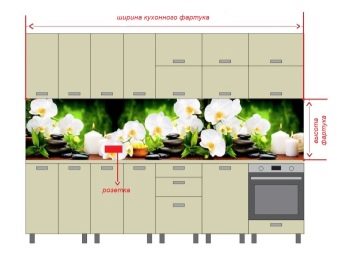
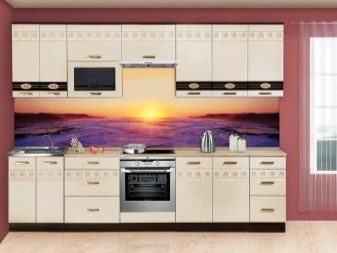
- Design... Due to the wide choice of design solutions, it is sometimes difficult for the buyer to decide on the appearance of the future apron for the kitchen. It should be noted here that the color scheme of the plastic should be combined with the style of the kitchen interior and furnishings. Experts advise against buying materials in dark colors or surfaces with a glossy texture. The slightest contamination will be visible on them.If there is a fear of acquiring plastic that is unsuitable in color and design, it is recommended to give preference to an apron with a neutral color scheme. This includes panels with beige, white, gray tones, as well as geometric prints.
You should not buy plastic at a price lower than the market price from a dubious manufacturer. As a rule, such products are of poor quality.
When buying, you need to demand from the seller certificates and other related documentation for the goods... Otherwise, there is a high risk of acquiring plastic or material that is unhealthy and has poor thermal and moisture-repellent properties.

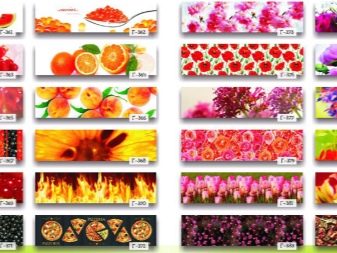
Installation features
Before installing plastic panels, tiles or lining, you need to check the quality of the wall. If the surface is relatively flat, installation can be done directly on it. If there are protrusions or deep pits, it is best to make a frame with wooden planks. Plastic should be fixed on them with self-tapping screws. For masking fasteners, it is best to use special furniture plugs.
If the canvas is planned to be mounted directly on the wall, it is advisable to prepare the surface. To do this, it must be cleaned of dirt and dust removed. The finished surface must be clean and dry. Next, you should start measuring and cutting the material. Any type of plastic is cut with a hacksaw with fine and frequent teeth or a sharp construction cutter.
The canvas is attached to the wall using:
- specialized glue;
- liquid nails;
- self-tapping screws.
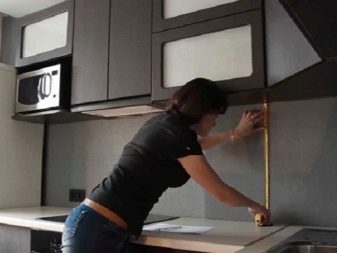
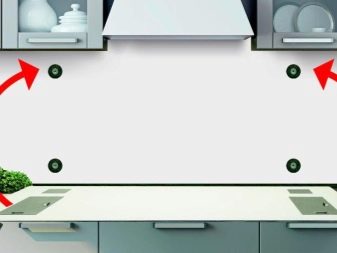
The first and second options are ideal for walls with minimal external defects. The procedure is simple: to fix the material, you need to apply an adhesive to the back of the sheet and press the apron against the wall. After that, 1-2 minutes are expected. The plastic quickly and easily adheres to the surface, however, then problems with dismantling the apron may arise.
To mount plastic on self-tapping screws, you must first make holes in the material and the wall. The accuracy of the work will ensure the use of a building level and markings. After drilling through the wall, dust is thoroughly removed. Residual dirt can show through the transparent plastic, which will reduce the aesthetics of the apron.
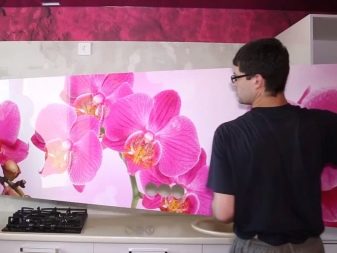
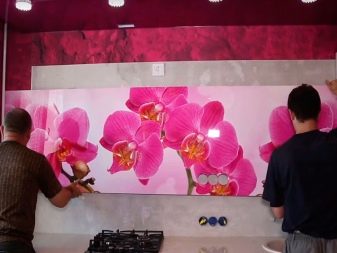
Subtleties of care
It is important to properly care for your plastic kitchen apron. Compliance with certain rules will extend the service life of the installed blade.
To keep wall panels clean without major labor costs, they should be wiped with a soft, damp cloth immediately after cooking.
Fresh grease stains can be easily removed from the surface. It will be much more difficult to deal with old pollution. Some housewives make a big mistake - rubbing dried dirt with a metal sponge or using products with coarse abrasive particles. As a result, the dirt is removed along with the paint on the panels. As a result, abrasions and deep scratches are formed on the surface of the canvas. Such defects are the reason for replacing a damaged canvas with a new one.
To avoid mechanical damage to plastic when cleaning it, a number of rules should be followed:
- when washing it is allowed to use only soft sponges and fabrics;
- for cleaning, you can use any means intended for washing dishes;
- you cannot use powder or cleaning agents in their pure form - they must first be dissolved in water;
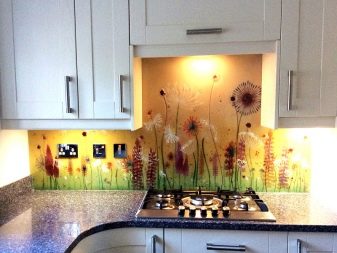
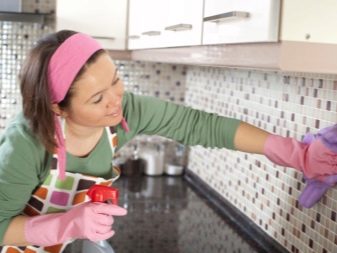
- it is forbidden to use products containing solvents or other chemically aggressive components (otherwise, bubbles may form on the plastic surface);
- a contaminated apron can be wiped with a solution of vodka and water (the components are taken in a 1: 1 ratio, the product is only suitable for monochromatic materials);
- so that no streaks remain on the surface, especially for transparent and glossy panels, cleaning should be completed by thoroughly wiping the canvas with a dry cloth or napkin.
It is not recommended to use acids such as lemon juice or vinegar to care for your apron. These substances can discolor the canvas or lead to a loss of gloss.

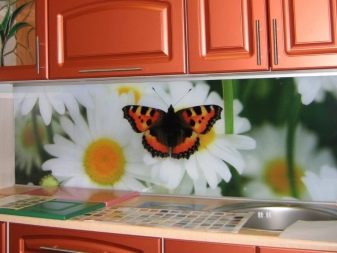
Consumer reviews
There are few laudatory responses on the network for plastic aprons. Mostly they are appreciated for their low cost. Plastic cloth - the ability to quickly and inexpensively update the kitchen environment. This is what attracts people in the first place and prompts them to make a rash purchase.
Consider the advantages that are noted by those who decide to purchase a plastic apron:
- aesthetics - plastic panels look bright and original;
- easy do-it-yourself installation using available tools.
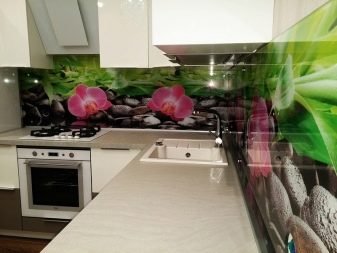
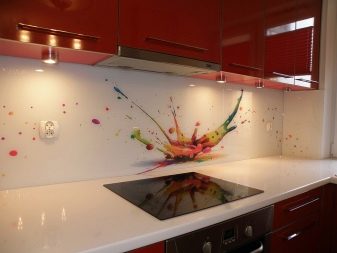
Buyers also note serious disadvantages of plastic. First of all, they include weak resistance to high temperatures.
Judging by some responses, panels installed next to a gas stove or hob deform and swell. They are not meant for such a "neighborhood". This problem can be avoided by installing another material that is more resistant to high temperatures in the area of the hob, such as glass or ceramic tiles.
The disadvantages include the fragility of the material. This disadvantage is especially noticeable when cutting products. Plastic panels can break if used with an unsuitable tool. There are also great risks of breakage of the apron during accidental power loads.
Some consumers attributed the fragility of plastic to a disadvantage, others noted it as a virtue. This factor has become an advantage for those who are accustomed to often changing the environment, making changes to the interior of the room. For such people, a plastic apron is a godsend. It allows you to decorate the kitchen working area in an original way with minimal financial costs.
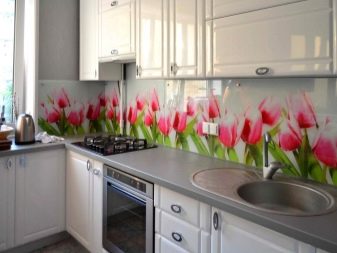

For information on how to install a plastic kitchen panel, see the next video.













The comment was sent successfully.